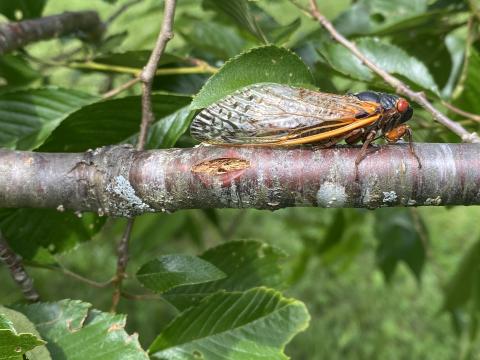All the Buzz About Cicadas

Periodical cicadas are in high numbers this year. The brown wound in the twig is where the female has cut a slit to lay eggs. This sometimes kills small twig ends.
By Steve Roark
Volunteer Cumberland Gap National Park
Though their numbers vary from place to place, you likely have seen and for sure heard the periodical cicada, which has emerged this year in vast numbers and is creating a loud drone during the warm part of the day.
Cicadas are native insects of which there are many species. Most show up every year, but seven species have synchronized development and come out periodically in large numbers, hence their name periodical cicada. There are two cycles of them, a 13-year and a 17-year cicada. They emerge regionally in different years, each called a brood. What we are witnessing right now is Brood XIV (14). Once they are gone, they won’t return until 2042.
What we are experiencing is the activity of the adult stage of the insect, which only lasts about five weeks, with the sole purpose of mating and laying eggs for the next brood. Periodical cicadas spend 99.5 percent of their lives underground in the top two feet of soil, feeding on tree roots, using sucking-type mouthparts to obtain sap filled with water and nutrition. While underground, they go through five stages of development called instars, each requiring they shed their exoskeleton as they grow bigger. The fifth and final instar is the one that burrows out of the ground, finds a vertical surface, and goes through a final molt where the adult version emerges, leaving the brown shell that you see everywhere. This happens from mid-May to mid-June.
The adults are large and colorful, the eyes being red and the body black with transparent wings with orange veins. There can be over a million per acre, but several hundred thousand is more common. Mating involves the males singing a species-specific song using something called a tymbol (think tambourine) that creates a buzzing noise. Our Brood 14 sings a “weeeeee-oh” sounding song that in large numbers simply sounds like a constant drone. Some say the cicadas are saying “phaaaaa-roh”, referring to the locusts that through Moses plagued the Egyptian pharaoh. However, cicadas are not locusts but were named that by early colonists.
Once mated, the female uses a sharp tube called an ovipositor to scratch a slit into a small tree branch and lays about 20 eggs in it. She can lay over 600. These slit wounds cause only minor damage to larger trees but can kill small diameter twigs. This can also impact fall acorn production in oak trees, which can be hard on squirrel and deer populations.
The reason for these massive numbers of cicadas showing up all at once is a survival technique called predator satiation. There are so many bugs that predators such as reptiles, birds, squirrels and other mammals simply cannot possibly eat enough to hurt their chances of reproduction. Wild turkey populations are known to increase after a cicada emergence due to gorging on these nutrient rich insects.
- Log in to post comments